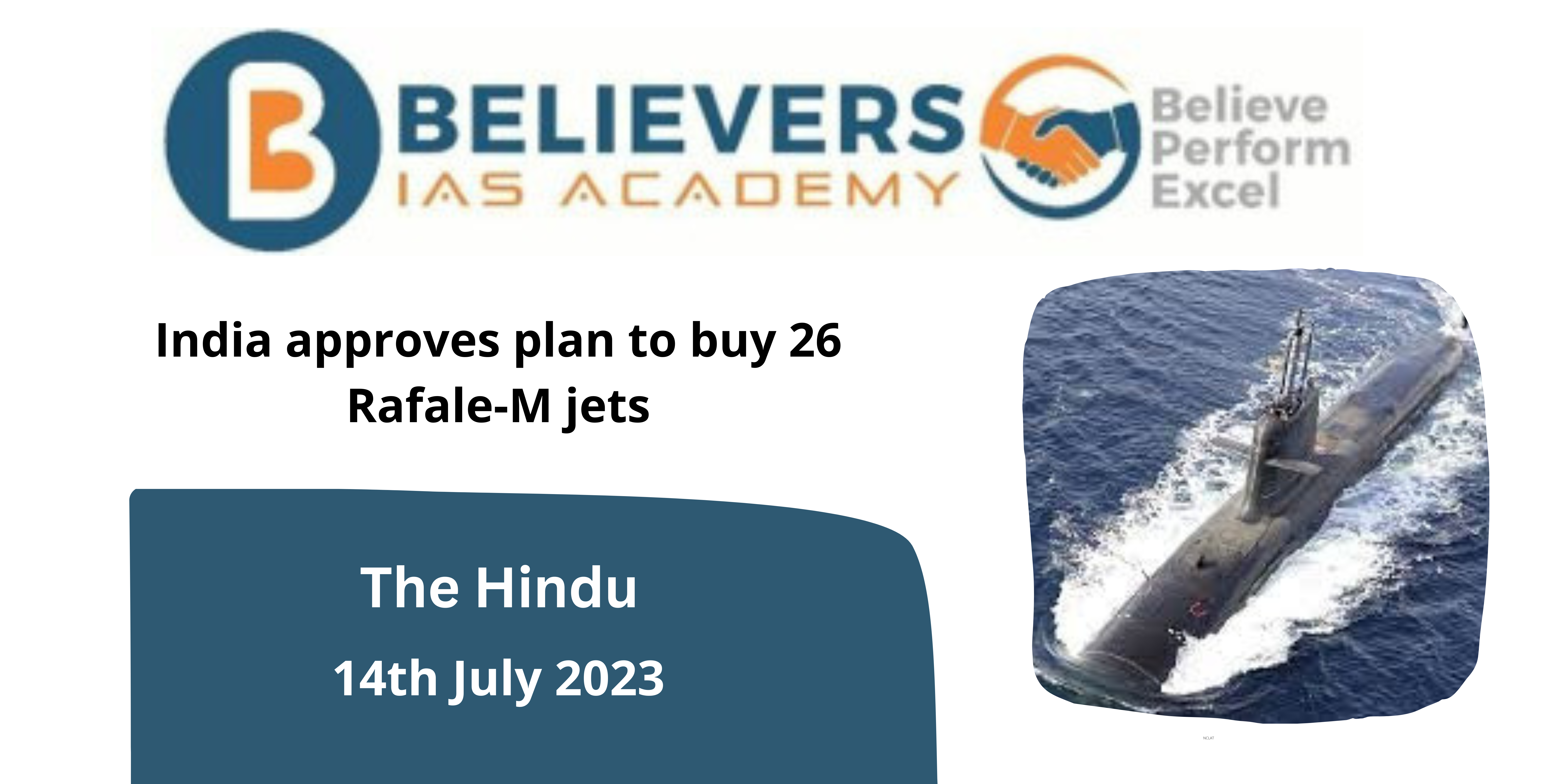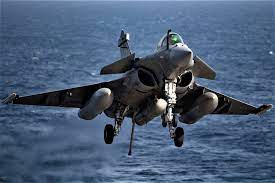India approves plan to buy 26 Rafale-M jets
Context
On Thursday, the Defence Acquisition Council (DAC), presided over by Defence Minister Rajnath Singh, gave its approval for the purchase of three additional Scorpene-class diesel-electric submarines from France as well as 26 Rafale-M fighters, which will be operated off aircraft carriers.
What is Defence Acquisition Council and who are its members?
- A significant organization in India’s defence establishment is the Defence Acquisitions Council (DAC). It is in charge of making choices about purchases and procurement for the defence industry and is made up of numerous senior individuals. The parts and duties of it are described as follows:
- Grant ‘in principle approval for capital purchases under the Long Term Perspective Plan (LTPP), which spans 15 years at the start of a Five Year Plan period. The “Make” projects in the Perspective Plan that have lengthy gestation periods are identified by this approval.
- ‘In principle’ acknowledge the necessity of each capital acquisition project for inclusion in the upcoming Five Year Plan, at least nine months before the start of the plan’s first year. To do this, projects must be classified as “Buy” (outright purchase), “Buy and Make” (buy followed by licensed manufacture or indigenous development), or “Make” (independent production and R&D).
- Based on input from the Defense Procurement Board, track the advancement of significant projects.
How does their DAC works?
- The Defence Procurement Board, Defence Production Board, and Defence R&D Board carry out the decisions made by the DAC when it convenes.
- The first step in the process of “acceptance of necessity” by the concerned administrative wing in the Ministry of Defence, in cooperation with Defence (Finance), is the approval in principle from the DAC.
- Based on the DAC’s discussions, the Raksha Mantri makes the ultimate choices, which, if necessary, may also be forwarded to the Finance Minister or Cabinet Committee on Security for consideration.
Who are the members of the DAC?
- Chairman: Raksha Mantri (RM) – The Minister of Defense, who chairs the council.
- Members:
- Raksha Rajya Mantris (RRMs) – Deputy Ministers of Defense.
- Chief of Defence Staff (CDS) – The principal military advisor to the government (when appointed).
- Chief of Army Staff (COAS) – Head of the Indian Army.
- Chief of Naval Staff (CNS) – Head of the Indian Navy.
- Chief of Air Staff (CAS) – Head of the Indian Air Force.
- Defence Secretary – The highest-ranking civilian bureaucrat in the Ministry of Defence.
- Secretary, Department of Defence Production and Supplies – Responsible for defence production.
- Secretary, Defence Research and Development – Responsible for defence research and development.
- Secretary, Defence Finance – Responsible for defence finances.
- Vice Chief of Defence Staff (when appointed) / Chief of Integrated Defence Staff (CISC) – The second-highest-ranking military officer and head of the Integrated Defence Staff.
- Special Secretary (Acquisition) – Responsible for defence acquisitions.
- Member Secretary: Deputy Chief of Defence Staff (Planning and Perspective, Financial and Capital Acquisition) – Responsible for coordinating and facilitating the council’s functions.
What is the latest addition to the Armed Forces through DAC?
- Rafale-M fighter purchase:
- The Defence Acquisition Council (DAC) has given its approval for the Indian Navy to purchase 26 Rafale-M jets.
- The approval covers all auxiliary gear, weaponry, training aids, spare parts, documentation, and logistical support.
- An Inter-Governmental Agreement (IGA) with the French government serves as the foundation for the procurement.
- With the French government, the purchase price and other parameters will be negotiated while taking into account the comparative procurement costs of similar aircraft by other nations.
- The deal will also call for the integration of machinery created in India and the creation of a hub for system maintenance, repair, and operation.
- There will be four twin-seat trainers and 22 single-seat jets in the Rafale-M fighter fleet.
- The Rafale-M planes will fill the gap until an indigenous deck-based fighter is developed, which may not be long enough for the Indian Navy’s current MiG-29Ks.
- Scorpene-class submarine acquisition:
- The purchase of three further Scorpene-class submarines for the Indian Navy has also been approved by the DAC.
- Mazagon Dock Shipbuilders will build the submarines as part of the Buy (Indian) category.
- The Indian Navy will be more operationally ready because of these submarines’ stronger indigenous content, which will also generate domestic jobs.
- Six Scorpene-class submarines are currently being constructed as part of Project-75 and a technology transfer deal with Naval Group.
- The $3.75 billion transaction that started the project was inked in 2005, and it is now almost finished.
How is Rafale going to give an edge to the Indian Navy and why did we choose them?
- Advanced Weapons Package:
- Beyond Visual Range (BVR): Advanced Weapons Package Advanced BVR air-to-air missiles on the Rafale enable it to engage adversarial aircraft at a range of more than 100 kilometers. Compared to missiles of American origin, these have a greater range and performance.
- Air-To-Ground Scalp Missiles:SCALP missiles, which are long-range precision ground attack missiles, are carried by the Rafale aircraft. They are able to locate and strike targets even far within enemy territory.
- Long-Range Precision Ground Attack Missiles: The Rafale is equipped with long-range precision ground attack missiles that can precisely target distinct targets and allow for pinpoint attacks on adversary locations.
- Stealth and Tracking:
- Reduced Radar Cross-Section:The Rafale employs stealth elements, such as its form and materials, to lower its radar cross-section. Stealth and Tracking: Reduced Radar Cross-Section. This increases its survival by lowering the chance of adversary radar detection.
- Advanced Avionics: The Rafale’s electronic warfare and advanced avionics equipment enable the aircraft to identify and engage hostile targets while reducing its own visibility to hostile radar systems. This enables it to tracklessly attack enemy jets at a great distance.
- Targeting systems and helmet-mounted sights:
- Helmet-Mounted Display: The Rafale has a technology that lets pilots project important data onto their visors through a helmet. As a result, they have better situational awareness and can engage targets more quickly.
- Advanced targeting systems are installed in the aircraft and function in tandem with the helmet-mounted display. These systems enhance the efficiency of weapon deployment by allowing pilots to track and engage targets fast and precisely.
- Quick Deployment: Operations at High Altitude: Even in cold start circumstances, the Rafale is capable of taking off from high altitude air bases like Leh. This increases its operating flexibility and enables speedy deployment as well as operation from difficult terrain and inclement weather.





